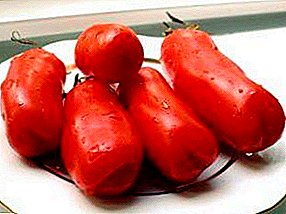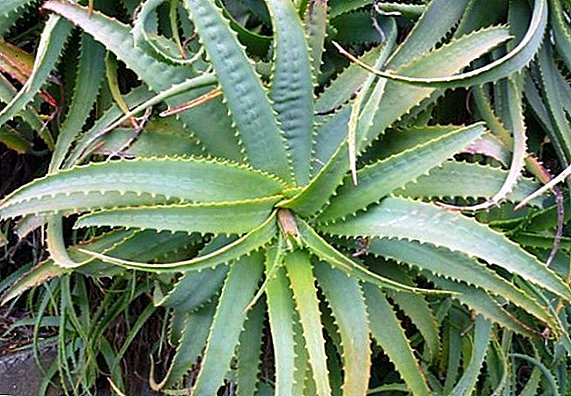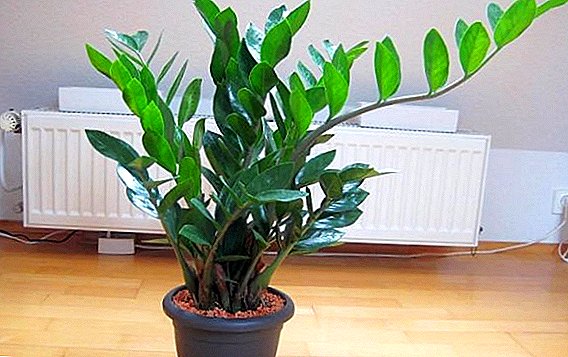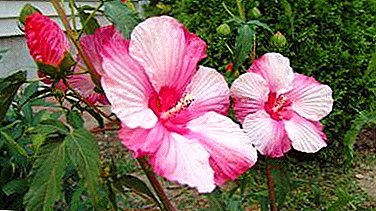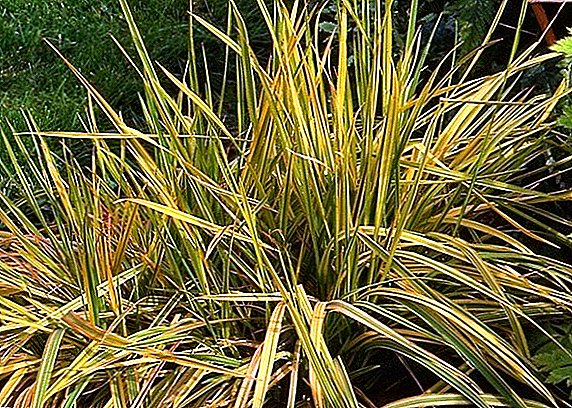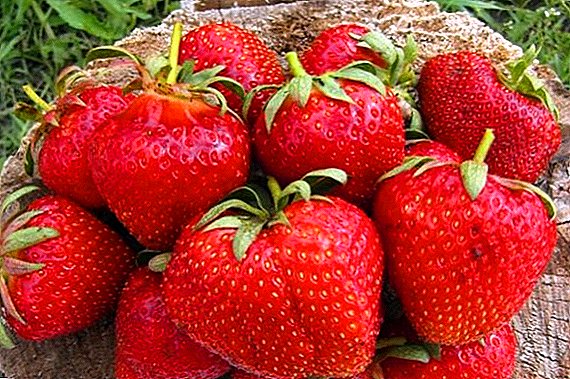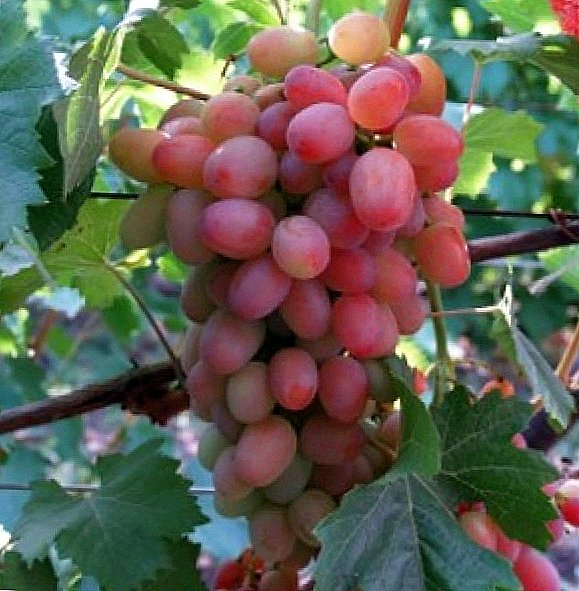
If you decide to plant grapes in your garden, then a number of legitimate questions will appear, the first of which will be "And what sort of plant to plant?".
One of the answers to this question may be the grape "Helios".
Shrubs of this variety will delight you not only with its attractive appearance, but also the amount of harvest.
The features of fit and care are described below.
Description of the grape variety "Helios"

The grape "Helios" was obtained by the breeder V. Kraynov. from crossing varieties "Arcadia" and raisin "Nakhodka". The second name of "Helios" - "Arcadia Pink".
This is a table grape variety, a hybrid. is he refers to early varieties, since it matures in 110 days.
Harvest ready for harvest in early August. Bushes are vigorous, tall, bisexual flowers. The clusters are weighty, the mass can reach up to 1.5 kg, they resemble a cone or cylindrical cone. The berries are shaped like an oval, very large, pink.
The weight of one fruit comes to 15 g, 32 x 23 mm in size. The skin is pink, medium thickness. The flesh is juicy, with nutmeg taste, sweet. Flowers bisexual. All shoots mature well.
High yieldstable Frost resistance is high, up to -23 ° C. Sufficiently high resistance to mildew and oidium. Bunches of "Helios" can be easily transported, while they will not lose their excellent presentation.
Virtues:
- excellent taste
- short aging period
- high frost resistance
- almost unaffected by fungal diseases
- high yield
- well maintains transportation
disadvantages:
- needs constant care
It is also interesting to read about the autumn harvesting cuttings of grapes.
About the features of planting varieties

The grapes "Helios" is quite a capricious plant, so it is recommended to plant it in fertile soils, otherwise it simply will not take root.
The distance between the bushes should reach 2.5 - 3 m, so that the roots of different bushes have enough space. As for planting time, it can be either spring or autumn. Due to the high frost resistance, seedlings that are only “planted” in the soil and covered for the winter will not die during the cold season.
Physical characteristics of seedlings are extremely important. Each of them should have well developed root system. The ripened shoot should be green, 20 cm in length.
Before planting, the seedling must be "revived", that is, shorten the lateral roots up to a length of 10 - 15 cm, and cut off a matured shoot at the level of the fourth or fifth bud. If such shoots on a sapling 2, then you need to remove the weakest.
12 - 24 hours before planting, it is desirable to lower the roots into a weak solution of growth enhancers. For planting, you need to dig up each seedling in a pit 80x80x80 cm, while clearly separating 2 types of earth: the lower layer and the upper layer.
The top layer should be mixed with humus, superphosphate, potassium salt, poured into the pit with a layer of 30-40 cm and well compacted. Next on this layer you need to put a sapling, which is covered with earth from the bottom layer. This land also needs to be well tamped.
Do not fill the pitit is better to leave a hole around a sapling 5–10 cm high and a radius of 20–30 cm. After planting, the seedling needs to be watered (2–3 buckets per 1 sq. m), loosen the soil after absorbing moisture, and cover the left well with mulch.
Care of the grade "Helios"

- Watering
With irrigation bushes varieties "Helios" need to be careful, since excess moisture can badly affect the yield. Therefore, in spring, when the temperature does not reach zero even at night, it is necessary to water the bushes of grapes plentifully.
You can not bring water into the ground until the temperature can become sub-zero, as the water in the ground will freeze and damage the root system of the vines. After trimming the bushes need to be watered again.
Before flowering, after flowering and during the growth of berries, the bushes are especially in need of moisture, so it is very important to water the grapes during this active phase of the growing season.
Before you cover the grapes for the winter, you need to do the so-called water recharge irrigation, that is, to provide the roots with water for the period of cold. The volume of regular watering is about 2 to 3 buckets per 1 square meter, while water retention irrigation is very abundant and reaches 5 to 6 buckets per 1 square meter.
- Mulching
For the earth to keep moisture longer, the soil needs to be covered with mulch. As the desired material, you can use straw, foliage, even mowed grass with vegetable batwa. The thickness of the layer of organic mulch should be at least 5 cm, otherwise there will be no sense from this procedure.
Today, the agricultural market has a mass of new materials that can be used for these purposes. One of the checked and most suitable materials is the boy-paper. It should be used on the basis of instructions.
- Harboring
Grape "Helios" very frost resistant, but in the absence of constant care, the bushes may die. And especially this probability increases in winter when the temperature drops far below zero. Therefore, if in your region the temperature in winter drops low enough, the shelter of the grape bushes is simply a necessary procedure.
To do this, each bush needs to be "divided" in half, to tie these parts of the bush and to lay these connected parts on the ground, having previously placed some material under them (for example, polyethylene). Be sure to secure the vines on the ground so that they could not climb.
On the whole row of already laid bushes it is necessary to install iron arcs on which polyethylene is stretched. In the case of Helios, one coat of coating will suffice. Be sure to ensure that the shoots do not touch the film, otherwise burns on the vine.
In addition to this method of shelter, there is also another - the protection of the earth. To do this, the bushes must also be divided and laid on the ground, and then sprinkled with earth, and so that a mound is formed. When it is cold, snow can also be used as an additional protection.
- Pruning

For the "Helios" variety the situation is typical overload on the vines, causing a harvest to suffer. Therefore, trimming the bushes of this particular grape is simply necessary.
Another feature of "Helios" is the fact that it should be cut in the spring. Therefore, in early spring, when the bushes have not yet entered the active growing season, it is necessary to distribute the load on the vines.
On one peephole there should be no more than 35 peepholes, and the fruiting vines should be shortened at the level of 6 to 8 peepholes. If you need to trim the seedling, then every year you need to shorten the annual escape at the level of the corresponding eye.
- Fertilizer
Like any other grape, the "Helios" variety needs additional fertilizers for active growth and fruiting. Therefore, mineral fertilizers are applied annually to the soil, and once every 2 to 3 years it is necessary to apply organic matter.
After you have opened the bushes after the winter, you need to add nitrogen to the soil, namely ammonium nitrate. Increasing the amount of this particular chemical element will increase the power of growth and development of bushes.
In addition to nitrogen, bushes need phosphorus and potassium, so before flowering and after it you need to add superphosphate and potassium salt to the soil. Organic fertilizers are humus, peat, compost and the like. It is desirable to combine dressing with watering.
- Protection
Helios resistant to fungal diseasesbut preventive measures are needed. The presence on the leaves or yellow spots, or gray dust suggests that the bushes "sick" mildew or oidium, respectively.
Fungicides and a solution of Bordeaux liquid (1%) will work against fungal diseases. Processing of the bush is carried out when the shoots reach a 20-centimeter length, before flowering and after it.
If you follow such instructions, your grapes will not only be actively developed, but also 3-4 years after planting will produce a stable crop.


